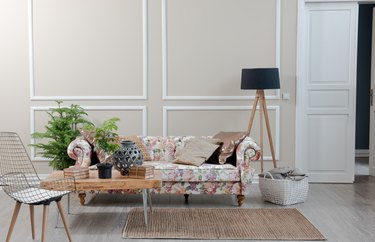
When choosing a lamp and installing the shade, it's important to know if it has a lamp harp or requires another type of fitter on the shade. Whether a table, floor or hanging lamp, the method of attaching the shade varies, depending on the fixture. No matter what shade style you choose, its size and fitter should match the lamp base.
Basics of Lamp Shades
Video of the Day
Lamp shades are available in several styles, from the traditional slant-sided round empire to square and novelty shapes. An empire or bell-shaped shade directs light downward, while a round drum, square or rectangular shade directs light equally up and down. Novelty shades vary in their ability to diffuse and direct the light from the lamp.
Video of the Day
When selecting a shade, size matters. In general, a lamp shade should be approximately one-third of the overall height of the lamp and the widest part of the shade should be twice the width of the lamp base. Adjust your measurements proportionally, up to 2 inches in each direction, depending on the style of the lamp and the type of shade. For example, a candlestick-style or novelty lamp may require a slightly taller and narrower shade to make it "look right" in the room.
Types of Fitters
There are three main types of lamp fitters. The most common is the spider, which includes three or four arms that meet a ring that fits on top of a lamp harp. The lamp harp is a U-shaped metal piece that extends from the bottom of the lamp socket and around and above the light bulb. The shade is secured to the harp with a finial.
Clip-on fitters attach the shade to the light bulb. Available in two sizes, the clip-on clamps onto candelabra and regular-sized light bulbs. They do not work on spiral fluorescent bulbs. When using a clip-on shade, the maximum wattage for a candelabra bulb is 25 watts and a regular bulb is 40 to 60 watts; plus, the shade should be at least 1 inch away from the bulb for fire safety.
The UNO sits directly on the light socket, then the bulb is screwed into the fixture. Similar to the UNO, the Euro fitter incorporates a threaded base and is clamped down by a nut, then the light bulb is screwed into the fixture.
Lamp Shade Installation
After selecting a shade that fits onto the lamp shade holder, lower it onto the harp or light socket. Spider fitters require a screw-on lamp finial to secure the shade to the lamp harp. This can be a simple ball or a decorative element that matches the lamp base.
Clip-on shades simply clamp onto the light bulb. If you need brighter light, consider using an LED bulb instead of a higher wattage. LED bulbs are an energy-saving and safer option, particularly with clip-on shades, which are in direct contact with the bulb.
UNO and Euro shades are both placed over the light socket before screwing in the light bulb. In the case of Euro fitters, a threaded nut secures the shade, then you can add the light bulb.
Lamp Shade Adapters
Lamp shade adapters help adjust the height of the lamp harp or convert a lamp with a glass shade to a fabric shade. If the size and shape of the shade are correct, but it needs to rest a little higher on the harp, a shade riser screws onto the harp to add the extra height. Alternately, you can install a taller, shorter or wider lamp harp to accommodate the light bulb and lamp shade.
Vintage and antique oil lamps may feature a glass shade. To convert to an electric lamp with a fabric shade, you may need a lamp shade adaptor kit that provides a threaded push-through socket base to replace the original oil burner, harp and lamp cord set. Follow the manufacturer's instructions carefully to ensure a safe and aesthetically pleasing adaptation of your antique lamp. Be sure to save the elements in a clearly labeled storage container so if the lamp is restored to its original function, the parts will be available to the restorer.